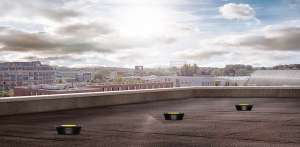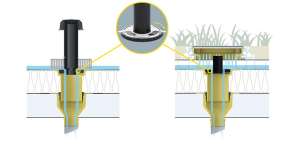Built in 2015, the terminal of Heydar Aliyev International Airport in Azerbaijan is located in the capital of Baku. The landmark terminal features interior architecture and experiential design by the globally acclaimed, Istanbul-based, Autoban studio.
Bearing all the hallmarks of the multidisciplinary studio’s experimental, genre-defying approach, the contemporary interiors overturn the traditional airport conventions of cavernous space and impersonal experience.
Commenting on the project, Seyhan Özdemir, Co-founder of Autoban said: “Aviation has always been a field that we felt very attached to. It started with us designing the head office for Turkish Do&Co – the company that operates gourmet meals for airlines in Turkey. Then came the interiors of the Turkish Airlines CIP Lounge at Ataturk Airport in Istanbul. That project was named among the 10 best airport lounges in the world. And now we have designed a complete airport. This is our largest commercial public project to date, and it gave us the opportunity to apply our expertise in hospitality on a much larger scale and to a wider audience.”

Azerbaijan Airlines initially approached Autoban in June 2012. According to Özdemir, the initial brief included all of the interior architecture of the terminal, which covers all sections and areas that are used by passengers. The design needed to reflect Azerbaijani culture, values, and its people, and so it was always going to be a human-focused environment, putting their needs first. The client wanted a space that evoked a feeling of warm hospitality and a contemporary presentation of traditional design touch points extended to a whole airport terminal.
“As a result of globalization, our travelling habits are changing rapidly and airports are fast becoming destinations of their own within the tourism industry. They are the welcoming faces of the countries, where you get the first impression about its culture. Keeping this fact in mind, the new Heydar Aliyev International Airport terminal was designed as a forward-thinking, modern building that fits the new face of the modern city of Baku,” said Özdemir.
Taking inspiration from Azerbaijani hospitality, Autoban’s Red Dot award-winning design spans the entirety of the terminal’s passenger spaces, and includes striking custom-made wooden ‘cocoons’, made using American white oak veneers, that create a sense of welcome and discovery, and opportunities to either meet or retreat. This use of narrative and unconventional forms is typical of Autoban’s idiosyncratic approach. For more than a decade, the studio has developed a reputation for its imaginative, human approach to design, creating spaces that are firmly rooted in cultural, social and geographic narratives, yet offer unexpected and thought provoking experiences to their inhabitants and visitors.
At Heydar Aliyev, their bespoke furnishings and lighting schemes upend airport typologies, opting for tactile natural materials such as wood, stone and textiles, gently and warmly lit. The cocoons – which vary in size and house an array of cafes, kiosks and other amenities – exist at the convergence of architecture and art, creating an inviting, intriguing landscape within the huge transportation hub that challenges expectations of the airport environment. Autoban have also conceived, designed and furnished four handsomely appointed ‘Salam Lounges’ exclusively for business class use, extending the best of their hospitality expertise to these premium passengers.

Explaining the design inspiration, Sefer Çağlar, Co-founder of Autoban said: “The keyword for us was ‘warm hospitality’. To achieve this, we adopted the architectural structure of the terminal and played with micro-architecture within the cavernous space to bring it down to a more human scale, so that it felt like a cocoon. This is not an airport where the space dictates. Instead, the people are in control. Travelling has become a huge part of our lives. So as designers we believe it’s our goal to make it as enjoyable as possible for the public by changing the fundamentals of such transportation hubs.”
There are a total of 16 cocoons – 11 are solid in form and are clad in wooden panels while 5 have open frameworks. The cocoons have a variety of uses; there are two cafes, a champagne and caviar bar, a play area for children, a spa and beauty shop, a music and bookstore, and some provide amenities such as luggage storage. Additionally, the use of the cocoons is flexible and it is expected they will change over time as the airport terminal evolves. Made using American white oak veneers, they were manufactured in Ankara under the supervision of METU engineering professors and then assembled on site. American white oak lumber and veneers, finished in a dark stain, were also used in the production of bespoke table and chair sets for various lounge areas in the new terminal.

Timber was specified because Autoban wanted to create a welcoming, comfortable and contemporary environment that generates a sense of belonging and homely feel for its users and to offer a brand new passenger experience at an airport. According to Çağlar, the main idea was to break away from the general airport typology. Initially, it was quite challenging to convince all of the international partners of the project but in the end, it turned out to be the part Autoban enjoyed the most out of the whole experience.
Explaining the extensive use of wood in the airport, Çağlar said: “There is a common belief that it is not, and there are many other preconceptions about airports that lead to a certain uniformity. We wanted to challenge this. Why not use wood at an airport? How can we incorporate wood into our design, and break away from the typology of conventional airports that overwhelm passengers with their scale, standards and technology? These were the questions. As a result, with the aid of innovative production technologies, wood became quite a practical material for the airport.”

The biggest design elements are the series of custom-made wooden ‘cocoons’, which the designers view as micro-architectural elements. In terms of the quantity of American white oak veneer used in the project, 6,000 square metres and 4,000 square metres were used for the cocoon shells and spandrel beams respectively. The largest cocoon is clad with 2,050 panels in 40 different sizes. To make the cocoons, Autoban played with natural materials and worked with craftsmen, but also used CNC milling and laser-cutting. Using Rhinoceros and AutoCAD to design the cocoons and 3DS Max to place the cocoons into the overall interior design, Autoban printed a 3D model of the open-framework cocoons and MAPA built a full-size mock-up in Ankara to test their functionality.
Commenting on the triangular structure of the building, which is also reflected in the entire interior, Özdemir says: “Triangular geometry comes from the architecture scheme and structural design of the airport building, and we continued this throughout the interior to present one strong fluid design. We believe architecture and interior design should be coherent. Using triangular forms was a way of respecting the architecture and adopting it for us.”

The terminal building’s conceptual architecture was designed by Arup, whilst Autoban was responsible for all of the interior architecture. Working with an in-house team of 15 consisting of architects, interior designers, furniture and lighting designers as well as engineers, the entire project took the leading studio less than 2 years to complete. In the first 8 months, Autoban worked on the design, and then followed up to ensure that the completed project was true to the initial design and client brief. The main contractor for the project was MAPA Construction Company whilst the interior joinery work was done by YOPA.
“We’ve been designing cafes, restaurant-bars and hotels for the last 11 years. So, the airport was like a huge playground for us to apply our imaginative, idiosyncratic, and human-centred approach in hospitality design. The response to the new terminal has been incredibly positive and the comment we hear again and again is that it doesn’t feel like being in an airport, which we take as a great compliment. Azerbaijani people are proud of their new airport because of the way it reflects what their country stands for,” concluded Çağlar.
Now spanning 65,000 square metres, more than six million passengers a year are expected to pass through the airport, enjoying Autoban’s thoughtful, highly functional and memorable gateway to the country and the wider Caucasus region.
Project: Heydar Aliyev International Airport
Client: Azerbaijan Airlines
Location: Baku, Azerbaijan
Main Architect: Arup, www.arup.com
Interior Architect: Autoban, autoban212.com
General Contractor: MAPA Construction Company
Interior joinery: YOPA
Project timespan: June 2012 – September 2014
American Hardwood Export Council, www.ahec.org
Foto: Kerem Sanliman, www.collectiff.com/bomonty

































